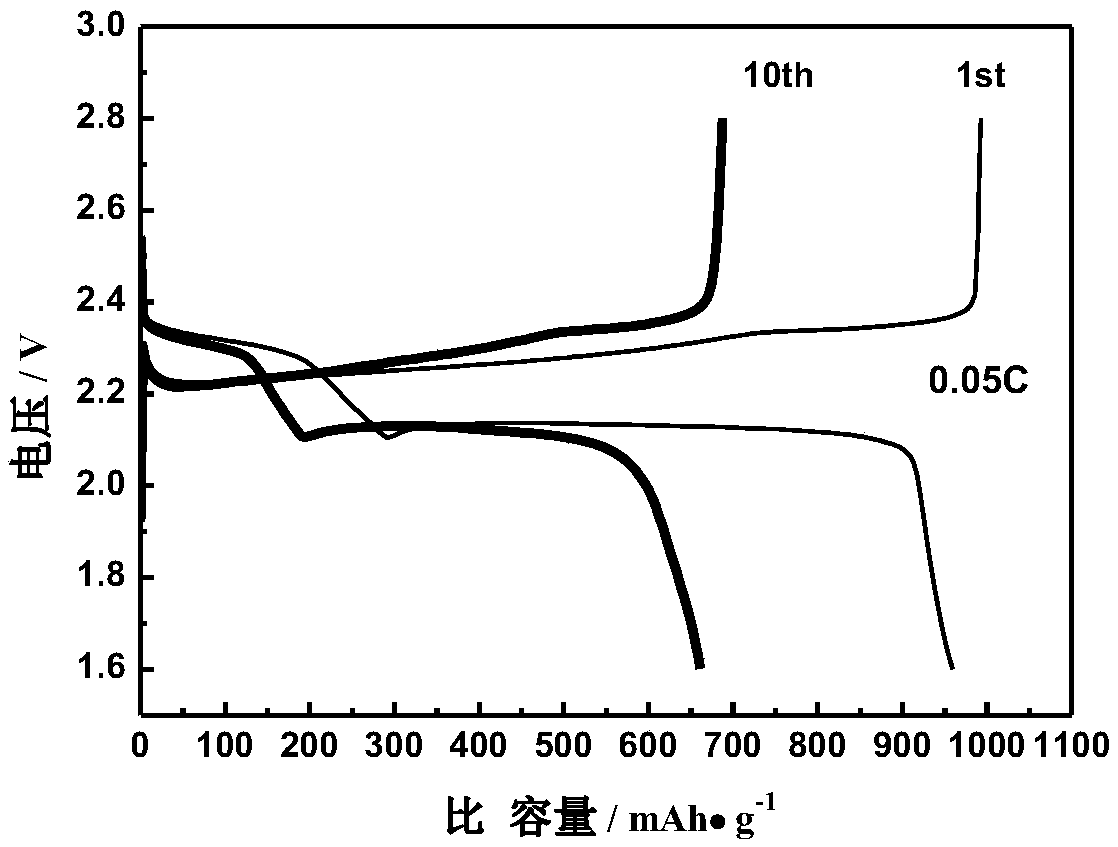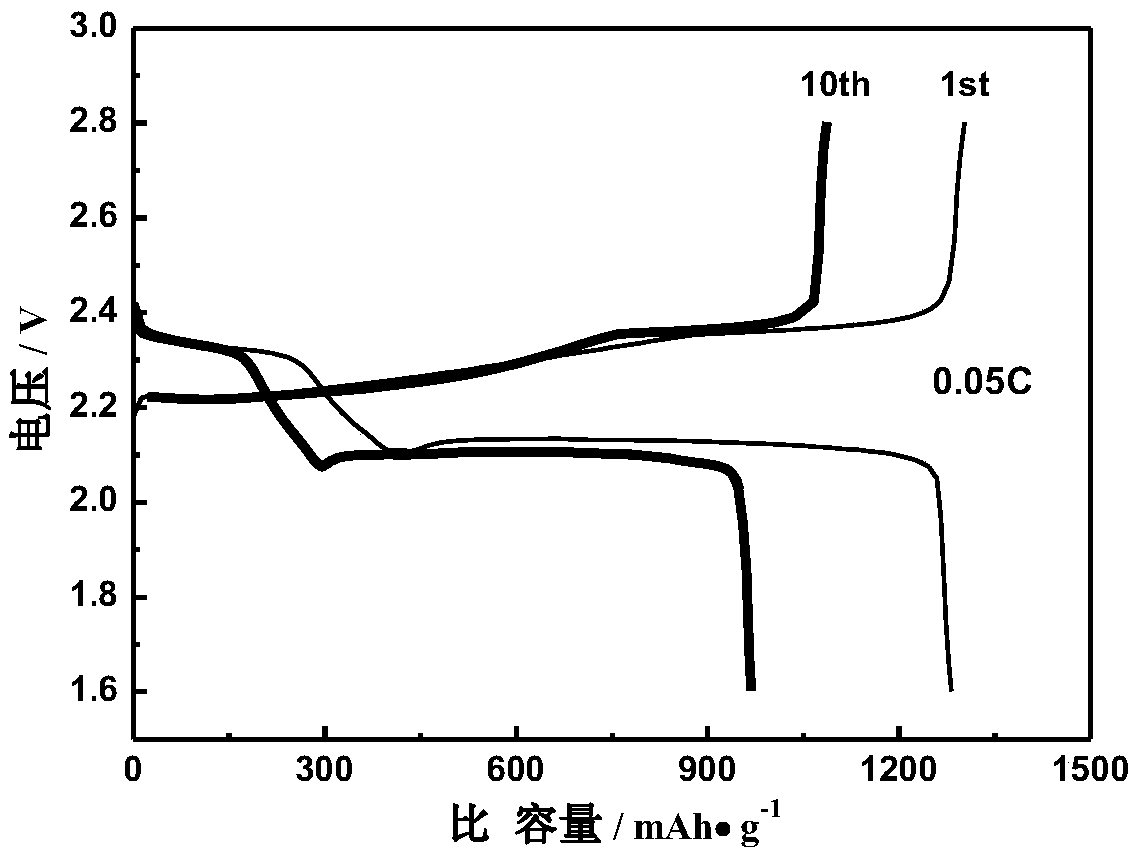A lithium-sulfur battery sandwich, a preparation method thereof, and a lithium-sulfur battery
A lithium-sulfur battery and interlayer technology, which is applied in the manufacture of battery electrodes, lithium batteries, and electrolyte batteries, can solve problems such as the deterioration of lithium-sulfur battery cycle stability, and achieve the effects of improving electrochemical performance, inhibiting the shuttle effect, and preventing migration
- Summary
- Abstract
- Description
- Claims
- Application Information
AI Technical Summary
Problems solved by technology
Method used
Image
Examples
preparation example Construction
[0027] The present invention also provides a preparation method of the lithium-sulfur battery interlayer, comprising the following steps:
[0028] Mixing the shearing agent and the organic solvent to obtain a mixed solution;
[0029] The mixed solution is infiltrated into the carbon nanotube conductive paper to obtain a lithium-sulfur battery interlayer.
[0030] In the present invention, the shear agent is mixed with an organic solvent to obtain a mixed liquid; in the present invention, the organic solvent is preferably one or more of N-methylpyrrolidone (NMP) and ethanol.
[0031] After obtaining the mixed solution, the present invention infiltrates the mixed solution into the carbon nanotube conductive paper to obtain an interlayer; in the present invention, the volume ratio of the quality of the shearing agent to the organic solvent is preferably (1g: 200ml), More preferably (1 g: 150 ml), most preferably (1 g: 100 ml).
[0032] In the present invention, the carbon nanot...
Embodiment 1
[0071] Preparation of carbon nanotube conductive paper:
[0072] Disperse 0.5 g of ball-milled carbon nanotubes and 0.05 g of sodium lauryl sulfate in 200 mL of deionized water, sonicate for 30 minutes, and stir with a high-speed shear for 30 minutes to obtain a carbon nanotube dispersion;
[0073] Mix 0.5g of paper fiber with 500mL of deionized water, and use a high-speed shear to break the paper fiber into a paper fiber suspension;
[0074] The carbon nanotube dispersion and the paper fiber suspension were mixed, sheared for 30 minutes, and filtered under a negative pressure of 0.06Mpa to obtain carbon nanotube paper.
[0075] Preparation of interlayer:
[0076] Dissolve 0.5g of dithiothreitol in 20mL of NMP, uniformly infiltrate into the carbon nanotube paper; dry at 60°C for 12 hours, slice with a microtome to obtain the mezzanine.
[0077] Preparation of positive electrode sheet:
[0078] The active material sulfur, carbon nanotubes, conductive carbon black and polyv...
Embodiment 2
[0083] Preparation of carbon nanotube conductive paper:
[0084] Disperse 0.5 g of ball-milled carbon nanotubes and 0.05 g of sodium lauryl sulfate in 200 mL of deionized water, sonicate for 30 minutes, and stir with a high-speed shear for 30 minutes to obtain a carbon nanotube dispersion;
[0085] Mix 0.5g of paper fiber with 200mL of deionized water, and use a high-speed shear to break the paper fiber into a paper fiber suspension;
[0086] Mix the carbon nanotube dispersion with the paper fiber suspension, shear for 30 minutes, and filter under a negative pressure of 0.06Mpa to obtain carbon nanotube paper;
[0087] Preparation of interlayer:
[0088] Dissolve 1.5g of dithiothreitol in 20mL of NMP, and evenly soak into the carbon nanotube paper. Dry at 60°C for 12 hours, slice with a microtome the mezzanine.
[0089] Preparation of positive electrode sheet:
[0090] The active material sulfur, carbon nanotubes, conductive carbon black and polyvinylidene fluoride were ...
PUM
| Property | Measurement | Unit |
|---|---|---|
| Thickness | aaaaa | aaaaa |
Abstract
Description
Claims
Application Information
 Login to View More
Login to View More - R&D
- Intellectual Property
- Life Sciences
- Materials
- Tech Scout
- Unparalleled Data Quality
- Higher Quality Content
- 60% Fewer Hallucinations
Browse by: Latest US Patents, China's latest patents, Technical Efficacy Thesaurus, Application Domain, Technology Topic, Popular Technical Reports.
© 2025 PatSnap. All rights reserved.Legal|Privacy policy|Modern Slavery Act Transparency Statement|Sitemap|About US| Contact US: help@patsnap.com


